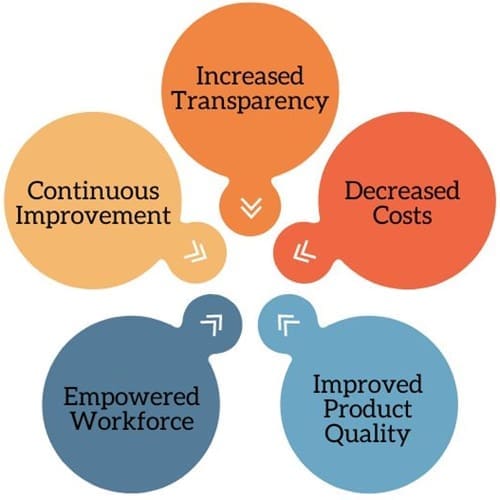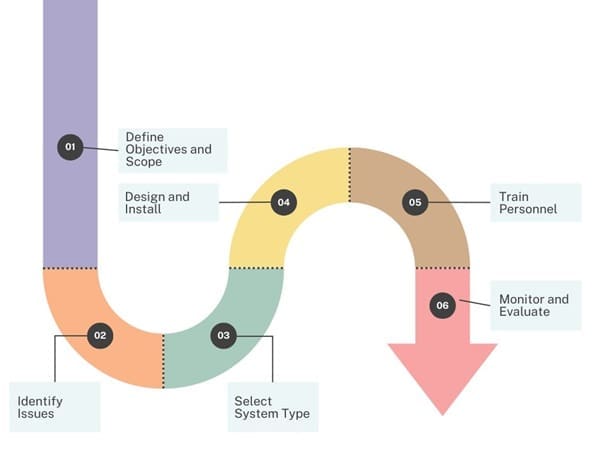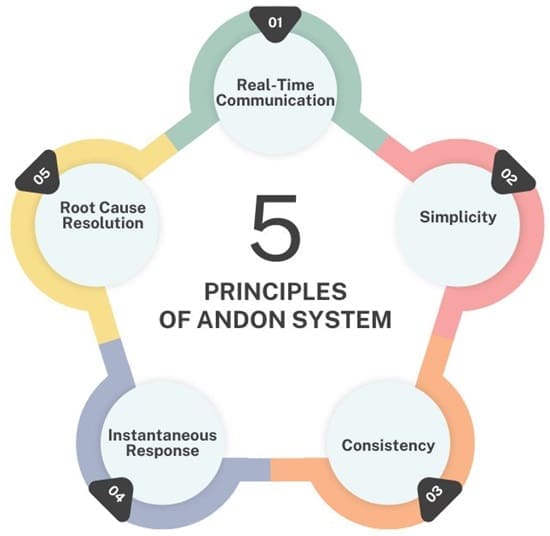Andon is a term derived from the Japanese word for “paper lantern.” When applied to manufacturing, an Andon system provides visual and auditory feedback regarding the status of production lines, signalling when assistance may be needed and providing immediate responses to quality or process issues. Lean manufacturing relies heavily on such systems.
Table of contents
- What is the Andon System?
- Key Components of Andon Systems
- Functionality of Andon Systems
- Types of Andon Systems
- Evolution of Andon Systems
- Benefits of Andon Systems
- Practical Examples of Andon Usage
- Implementation Steps for Andon Systems
- Best Practices for Andon Systems
- How to Use Andon in Lean Manufacturing?
- Basic Principles of Andon Systems
- Evolution and Modern Use of Andon Systems
- Final Words
- About Six Sigma Development Solutions, Inc.
- Related Articles
What is the Andon System?
An Andon system is a visual and auditory alert mechanism used in manufacturing environments to signal the status of the production process and indicate when immediate attention is necessary.
The word “Andon” derives its name from Japanese for “paper lantern,” reflecting its purpose of providing visible alerts. Lean manufacturing benefits greatly from such systems as they facilitate quick responses to any issues, allowing quality control processes to run more smoothly.
Purpose
An Andon system primarily facilitates communication on the production floor by enabling operators to instantly report problems that need attention, thus helping maintain continuous production flow and high-quality output.
Key Components of Andon Systems
An Andon system typically consists of several elements that work in concert to facilitate smooth operations and quick issue resolution:
- Andon Buttons/Cords: Operators use these to manually signal any production process problems.
- Andon Lights: These visual indicators use colour-coding schemes to indicate their status:
- Green: It implies operations running smoothly
- Yellow: It means there has been an issue that requires assistance.
- Red: The production line has been temporarily stopped due to an urgent issue.
- Andon Boards: Andon boards are visual displays used to communicate production line status and identify problems. They may take the form of large light indicators, ticker boards, alarms or automatic text alerts – each serving as an efficient means of keeping everyone informed while prompting prompt action when issues arise.
Functionality of Andon Systems
Andon systems play several essential roles in manufacturing:

- Real-Time Problem Identify: Operators can immediately notify of an issue, be it defects, shortages of materials or equipment malfunction.
- Immediate Response and Resolution: Whenever an Andon signal is activated, supervisors and support teams are immediately made aware of any problems, which prompts them to investigate further and take corrective actions to rectify the situation and resume production.
- Quality Control: By allowing operators to stop production for quality issues, Andon systems ensure that defects can be identified quickly and dealt with accordingly, thus preventing defective products from continuing down the line.
Types of Andon Systems
Andon systems can be divided into two main groups according to their method of activation:
- Manual Andon: Triggered by human intervention such as pulling a cord or pressing a button when an issue is discovered.
- Automatic Andon: Triggered automatically by sensors or production equipment that detect anomalies and signal an alert when detected anomalies arise, like pulling cords.
Evolution of Andon Systems
As time passed, Andon systems became more advanced with each passing year; initially using simple light signals to indicate line status. Nowadays they feature digital displays, automated alerts, and integrated data systems – providing more detailed tracking and analysis of production issues than ever before.
History of the Andon System
Andon production can be traced back to 1896 with Sakichi Toyoda’s invention of an improved power loom that could automatically stop when its weft thread broke, enabling operators to manage multiple looms simultaneously.
Development at Toyota
Taiichi Ohno, one of the key figures behind the Toyota Production System (TPS), refined this idea further into what is now known as Jidoka. There are two forms of Jidoka:
- Mechanical Jidoka: Equipment automatically stops when an issue arises.
- Human Jidoka: Operators stop production when they observe any issue arising in production.
Andon systems provide operators with a human Jidoka capability, empowering them to halt production if they detect quality issues or irregularities during production.
Benefits of Andon Systems
Implementing an Andon system has many advantages; here are just a few:

- Increased Transparency: Everyone on the production floor is informed about the current status and any issues, cultivating an atmosphere of openness and accountability.
- Decreased Costs: Early identification of problems reduces costly rework while cutting waste costs significantly.
- Improved Product Quality: By immediately addressing defects, Andon systems help ensure only high-quality products pass through production.
- Empowered Workforce: When workers have the authority to stop production to address quality issues, engagement and responsibility increase significantly
- Continuous Improvement: Ongoing feedback and prompt issue resolution ensure constant improvements to processes and quality.
Practical Examples of Andon Usage
Toyota’s Manufacturing Floor: As an early pioneer of Andon usage, Toyota utilizes Andon boards to monitor production lines. When they detect defects or other problems in production, operators can halt them quickly for immediate attention and resolution.
Automotive Dashes: Automotive dashboards are an eminent example of Andon in everyday life, using lights to notify drivers about issues such as low oil levels or engine malfunction.
Amazon’s Virtual Andon System: Amazon utilizes an automated alert system known as “The Virtual Andon System” for customer service purposes, notifying representatives when recurring product issues surface, enabling them to quickly stop shipping orders and address them immediately.
Implementation Steps for Andon Systems
To successfully implement an Andon system, follow these steps.

- Define Objectives and Scope: Establish its goals and scope based on customer needs and process characteristics
- Identify Issues: The andon system must detect as part of production process monitoring. When performing this step, establish how you would want the Andon system to function before proceeding further with implementation.
- Select System Type: Evaluate both manual and automatic Andon systems depending on your production environment and specific needs.
- Design and Install: Outfit the Andon system with necessary signals, codes, displays, and displays so it’s easily visible and audible for operation.
- Train Personnel: Provide operators, supervisors, and support teams with proper instructions for using the Andon system effectively.
- Monitor and Evaluate: Evaluate performance over time by tracking its usage stats, collecting feedback from users, and making any necessary improvements to enhance its use.
Best Practices for Andon Systems

- Empower Workers: Encourage workers to use the system actively and engage in problem-solving.
- Support Supervisors: Ensure supervisors respond quickly and positively to Andon signals.
- Coordinate Support Teams: Align support teams to assist efficiently with any issues.
- Communicate with Customers: Inform customers about the Andon system’s benefits and seek their feedback for continuous improvement.
Also See: Best Six Sigma Green Belt (SSGB) Certification
How to Use Andon in Lean Manufacturing?

Empower Operators
To successfully utilize an Andon system in Lean manufacturing, it is key that operators feel empowered. This means empowering them not only with permission but with obligation when problems arise; stopping production could seem counterproductive but addressing issues quickly can avoid major expenses down the line.
Trust Is Crucial
For operators to feel empowered when making decisions and stopping production lines on their own judgment, as per Lean’s principle of “Respect for People.” Otherwise, operators could hesitate, leading to unresolved issues which could become major headaches later.
Immediate Issue Resolution
For optimal operation of an Andon system, an effective plan must be put into place to address issues as they arise. A team should be in place that can perform root cause analysis and implement solutions quickly if any arise.
Knowing who is playing key roles ahead of time increases the speed and efficiency of issue resolution while delays could potentially discourage users from using the Andon system again in future.
Basic Principles of Andon Systems
Key Elements Signal: Operators have the authority to stop production when an issue arises, with Andon lights making line status and issues highly visible.
Alert: Away light helps make line issues highly visible, whilst Resolve: Both operators and supervisors work collaboratively to identify root causes and implement lasting fixes.
Underlying Principles

- Real-Time Communication: Immediate alerts ensure that any problem becomes a shared focus for finding a solution. This involves:
- Simplicity: Focusing on critical information.
- Consistency: Standardized visual cues (e.g., green for normal, yellow for slight deviations, red for immediate attention).
- Instantaneous Response: Quick reaction to visual cues by operators and supervisors.
- Root Cause Resolution: The system prioritizes long-term gains by addressing the root cause of problems, even if it means sacrificing short-term production.
Evolution and Modern Use of Andon Systems
Modern Andon systems have evolved to include various advanced features:
- Visual and Auditory Cues: Utilizing lights and sounds as alerts. Wireless Buttons: Reducing clutter and eliminating trip hazards by replacing cords with wireless buttons. Practical Applications
- Part Shortages: Alerting when parts run low. Defect Notifications: Informing employees of any potential defects detected within their facilities.
- Tool/Machine Malfunctions: Signalling equipment issues. Safety Issues: Calling attention to potential safety concerns.
Final Words
Andon systems are an essential element of lean manufacturing, offering an effective yet straightforward approach to maintaining quality and efficiency on the production floor. By offering real-time feedback to workers, and encouraging them to address issues quickly, Andon systems promote higher product quality, reduced costs, and a culture of continuous improvement.

About Six Sigma Development Solutions, Inc.
Six Sigma Development Solutions, Inc. offers onsite, public, and virtual Lean Six Sigma certification training. We are an Accredited Training Organization by the IASSC (International Association of Six Sigma Certification). We offer Lean Six Sigma Green Belt, Black Belt, and Yellow Belt, as well as LEAN certifications.
Book a Call and Let us know how we can help meet your training needs.












